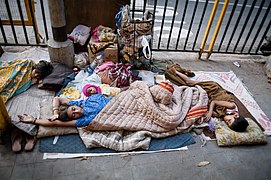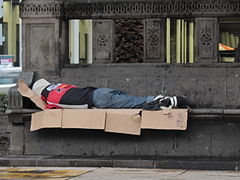Tunawisma

Tunawisma atau gelandangan adalah seseorang yang tidak memiliki tempat tinggal yang stabil dan layak. Seseorang dapat dikategorikan tunawisma jika: hidup di jalanan (tunawisma primer); berpindah antar tempat penampungan sementara, termasuk rumah teman, keluarga dan akomodasi darurat (tunawisma sekunder); tinggal di rumah kos pribadi tanpa kamar mandi pribadi atau tanpa jaminan kepemilikan (tunawisma tersier).[1] Definisi hukum tunawisma bervariasi dari satu negara ke negara lain, atau di antara yurisdiksi yang berbeda di negara atau wilayah yang sama.[2] Studi pencacahan tunawisma pemerintah Amerika Serikat[3][4] juga mencakup orang-orang yang tidur di tempat umum atau pribadi yang tidak dirancang untuk digunakan sebagai akomodasi tidur biasa bagi manusia.[5][6] Orang-orang yang kehilangan tempat tinggal sering kali tidak dapat memperoleh dan memelihara perumahan yang layak, aman, terjamin dan memadai karena pendapatan yang tidak konsisten atau sama sekali tidak memiliki pendapatan. Tunawisma dan kemiskinan biasanya saling berkaitan.[1] Tidak ada konsensus metodologis dalam menghitung tunawisma dan mengidentifikasi kebutuhan mereka; oleh karena itu di sebagian besar kota hanya perkiraan populasi tunawisma yang diketahui.[7]
Pada tahun 2005, diperkirakan 100 juta orang di seluruh dunia kehilangan tempat tinggal dan sebanyak satu miliar orang (satu dari 6,5 orang pada saat itu) hidup sebagai penghuni liar, pengungsi, atau tempat penampungan sementara, semuanya tanpa perumahan yang layak.[8][9][10] Secara historis di negara-negara Barat, mayoritas tunawisma adalah laki-laki (50-80%), khususnya laki-laki lajang.[11][12][13]
Jika dibandingkan dengan populasi umum, orang-orang yang tunawisma lebih banyak mengalami gangguan kesehatan fisik dan mental. Tingkat keparahan penyakit kronis, kondisi pernapasan, tingkat penyakit kesehatan mental, dan penyalahgunaan zat, semuanya seringkali lebih besar pada populasi tunawisma daripada populasi umum.[14][15] Tunawisma juga dikaitkan dengan risiko tinggi upaya bunuh diri.[16]
Ada sejumlah organisasi yang memberikan bantuan bagi para tunawisma.[17] Sebagian besar negara menyediakan berbagai layanan untuk membantu para tunawisma. Layanan ini sering menyediakan makanan, tempat tinggal (tempat tidur), dan pakaian dan dapat diatur dan dijalankan oleh organisasi masyarakat (seringkali dengan bantuan sukarelawan) atau oleh departemen atau badan pemerintah. Program-program ini dapat didukung oleh pemerintah, badan amal, gereja, dan donor individu. Banyak kota juga memiliki surat kabar jalanan, yang merupakan publikasi yang dirancang untuk menyediakan kesempatan kerja bagi para tunawisma. Beberapa tunawisma memiliki pekerjaan, tetapi ada pula yang harus mencari berbagai cara untuk mencari nafkah. Mengemis atau memulung adalah salah satu pilihan bagi mereka.
Galeri
- Tunawisma
-
Tunawisma di Tokyo
-
Tunawisma di Portugal
-
Tunawisma di New York City, Amerika Serikat
-
Tunawisma di Maroko
-
Tunawisma di Meksiko
-
Tunawisma di Nigeria
Referensi
- ^ a b Hanson-Easey, Scott; Every, Danielle; Tehan, Bridget; Richardson, John; Krackowizer, Antoinette (2016). "Climate change, housing and homelessness: Report on the homelessness and climate change forum (why are climate change and homelessness in the same category?)" (PDF). Diarsipkan dari versi asli (PDF) tanggal 14 April 2019. Diakses tanggal 18 March 2019.
- ^ "Glossary defining homelessness". Diakses tanggal 17 September 2014.
- ^ Bogard, Cynthia J., "Advocacy and Enumeration: Counting Homeless People in a Suburban Community" Diarsipkan 2016-01-25 di Wayback Machine., American Behavioral Scientist September 2001 vol. 45 no. 1 105–120
- ^ Gabbard, W. Jay; et al., "Methodological Issues in Enumerating Homeless Individuals", Journal of Social Distress and the Homeless Volume 16, Number 2 / May 2007 90–103
- ^ Office of Applied Studies, United States Department of Health and Human Services, "Terminology" Diarsipkan 23 December 2017 di Wayback Machine.
- ^ "United States Code, Title 42, Chapter 119, Subchapter I, § 11302". Diakses tanggal 17 September 2014.
- ^ Caves, R. W. (2004). Encyclopedia of the City. Routledge. hlm. 348.
- ^ "A roof is not enough – a look at homelessness worldwide, by Monte Leach, Share International Archives". Share-international.org. Diarsipkan dari versi asli tanggal 7 December 2017. Diakses tanggal 7 December 2017.
- ^ "Global Homelessness Statistics – Homeless World Cup". Homelessworldcup.org. Diakses tanggal 7 December 2017.
- ^ "Homelessness around the world". Boston.com. 14 December 2011.
- ^ Hurst, Charles E. (1 January 1998). Social Inequality: Forms, Causes, and Consequences
 . Allyn and Bacon. ISBN 9780205264841 – via Internet Archive.
. Allyn and Bacon. ISBN 9780205264841 – via Internet Archive.
- ^ Netherlands, Statistics. "17 homeless in every 10 thousand Dutch". www.cbs.nl.
- ^ Roleff, Tamara L (1996). The Homeless: Opposing Viewpoints – Google Books. ISBN 9781565103603. Diakses tanggal 17 September 2014.
- ^ Fazel, S; Khosla, V; Doll, H; Geddes, J (2008). "The Prevalence of Mental Disorders among the Homeless in Western Countries: Systematic Review and Meta-Regression Analysis". PLOS Medicine. 5 (12): e225. doi:10.1371/journal.pmed.0050225. PMC 2592351
 . PMID 19053169.
. PMID 19053169.
- ^ Shelton, Katherine; Taylor, Pamela; Bonner, Adrian; van den Bree, Marianne (2009). "Risk Factors for Homelessness: Evidence From a Population-Based Study". Psychiatric Services. 60 (4): 465–472. doi:10.1176/ps.2009.60.4.465. PMID 19339321.
- ^ Molnar, B; Shade, S; Kral, A; et al. (1998). "Suicidal behaviour and sexual/physical abuse among street youth". Child Abuse and Neglect. 25: 137–148.
- ^ Corinth, K. (2016). A tech revolution for the homeless: taking big data to the streets[pranala nonaktif permanen]. In AEI Paper & Studies (p. COVc+). Washington, DC: American Enterprise Institute. Retrieved from http://link.galegroup.com.ezp.mesacc.edu/apps/doc/A458953075/ITOF?u=mcc_mesa&sid=ITOF&xid=d57171bc[pranala nonaktif permanen]
Bacaan lanjutan
- Anderberg, Kristen (2011). 21st Century Essays on Homelessness. Seaward Avenue Press. ISBN 978-1-4565-3236-9.
- Arumi, Ana Maria, Yarrow, Andrew L., "Compassion, Concern, and Conflicted Feelings: New Yorkers on Homelessness and Housing" Diarsipkan 18 October 2017 di Wayback Machine., Public Agenda Foundation, February 2007
- Commonwealth of Massachusetts, Department of Housing and Community Development, Homelessness Commission, Commission to End Homelessness, "Report of the Special Commission Relative to Ending Homelessness in The Commonwealth", Final Report, December 2007
- Crosette, Barbara, "Homeless and Hungry Youths of India", The New York Times, 23 December 1990.
- Desjarlais, Robert R., Shelter blues: sanity and selfhood among the homeless, University of Pennsylvania Press, 1997
- Friedman, Donna H., et al., "Preventing Homelessness and Promoting Housing Stability: A Comparative Analysis", The Boston Foundation, June 2007.
- Howard, Ella (2013). Homeless: Poverty and Place in Urban America. Philadelphia: University of Pennsylvania Press. ISBN 978-0-8122-4472-4.
- Institute of Medicine (U.S.), Committee on Healthcare for Homeless People, "Homelessness, Health, and Human Needs", Washington, D.C. : National Academy Press, 1988. ISBN 0-309-03835-9
- Journal of Social Distress and the Homeless, Springer Verlag and Psycke-Logos Press.
- Massachusetts Coalition for the Homeless, 2005–2006 edition, first published in 1984, 15 Bubier Street, Lynn, Massachusetts.
- Katz, Jessica Ilana, "Homelessness, Crime, Mental Illness, and Substance Abuse: A Core Population with Multiple Social Service Needs", Department of Urban Planning and Studies, Massachusetts Institute of Technology, June 2003
- Kenyon, Thomas, What You Can Do to Help the Homeless (Simon & Schuster, 1991)
- Min, Eungjun, (editor), "Reading the Homeless: The Media's Image of Homeless Culture", Praeger Publishers, 1999. ISBN 0-275-95950-3
- National Coalition for the Homeless, "American Nightmare: A Decade of Homelessness in the United States", December 1989
- Nieto G., Gittelman M., Abad A. (2008). "Homeless Mentally Ill Persons: A bibliography review", International Journal of Psychosocial Rehabilitation. 12(2)
- O'Flaherty, Brendan, "Making room : the economics of homelessness", Cambridge, Mass. : Harvard University Press, 1996. ISBN 0-674-54342-4
- Office for Public Management (UK), "Tackling Homelessness: learning from New York" Diarsipkan 2009-08-10 di Wayback Machine., Seminar Report, London, England, February 2004
- Scanlon, John, "Homelessness: Describing the Symptoms, Prescribing a Cure", The Heritage Foundation, Backgrounder No. 729, 2 October 1989
- Miya Yoshida, "The Hidden Homeless in Japan's Contemporary Mobile Culture", NeMe, 2012
- Southard, Peggy Ann Dee, "Looking for Sanctuary: Staying on Publicly Owned Lands as a Response to Homelessness", a dissertation presented to the Department of Sociology and the Graduate School of the University of Oregon in partial fulfillment of the requirements for the degree of Doctor of Philosophy
- Tsesis, Alexander, "Eliminating the Destitution of America's Homeless", Temple Political & Civil Rights Law Review, Vol. 75, No. 539, 2002, Temple University Beasley School of Law
- University of Michigan Libraries, Selected Bibliography of Homelessness Resources
- Wright, James D. (1989). Address Unknown: The Homeless in America (edisi ke-Third). New York: Transaction Publishers. ISBN 978-0-202-36409-4.
Lihat pula
- St. Vincent de Paul Village - Penanggulangan masalah tunawisma di Amerika.
Pranala luar
- Homeless of New York - Article + Video Diarsipkan 26 March 2020 di Wayback Machine. – The Uncommon Magazine, by Avery Kim, 6 July 2016
| Cari tahu mengenai homelessness pada proyek-proyek Wikimedia lainnya: | |
| Definisi dan terjemahan dari Wiktionary | |
| Gambar dan media dari Commons | |
| Berita dari Wikinews | |
| Kutipan dari Wikiquote | |
| Teks sumber dari Wikisource | |
| Buku dari Wikibuku | |
| Entri basisdata #Q131327 di Wikidata | |
| Sumber pustaka mengenai Tunawisma |
- Homeless Statistics for Australia, Canada, United Kingdom and the United States, all data from around the year 2001.
- PBS, "Home at Last?"[pranala nonaktif permanen], NOW series program, first aired on 2 February 2007. The topic was what will most help homeless people reenter the fabric of society.
- Tunawisma di Curlie (dari DMOZ)
- Homelessness in Europe FEANTSA is the European Federation of National Organisations Working with the Homeless is an umbrella of not-for-profit organizations which participate in or contribute to the fight against homelessness in Europe.
- Report Card on Child Homelessness by the American Institutes for Research. Summarized in Child homelessness on the rise in US Diarsipkan 2014-11-29 di Wayback Machine. (November 2014), Palm Beach Post
- Utah found a brilliantly effective solution for homelessness (February 2015), Natasha Bertrand, Business Insider












